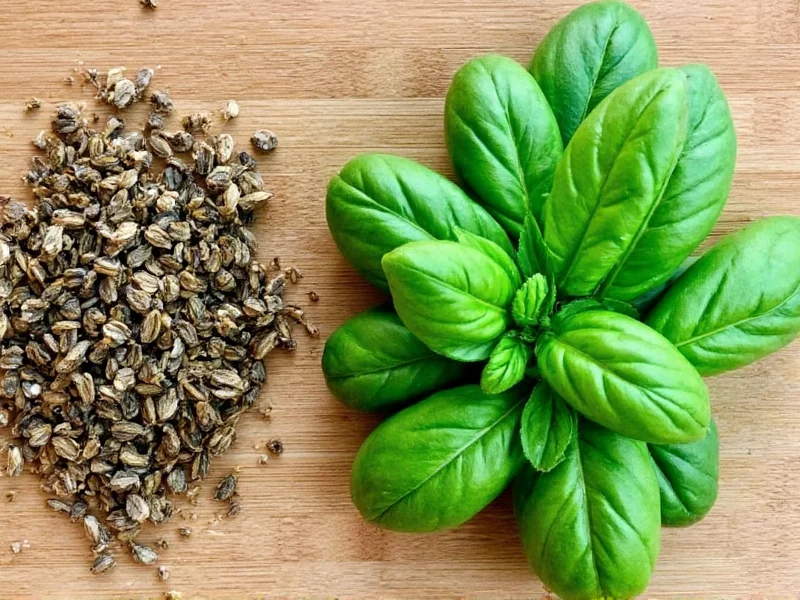Dried basil is approximately three times more concentrated than fresh, requiring a 1:3 substitution ratio (1 teaspoon dried = 1 tablespoon fresh). Fresh basil offers brighter, more complex herbal notes ideal for raw applications like pesto and caprese salad, while dried basil's intensified flavor works better in long-cooked dishes like tomato sauces and soups where its earthy notes mellow beautifully.
Understanding the nuanced differences between dried and fresh basil transforms your cooking results. While both originate from the same aromatic herb (Ocimum basilicum), their preparation methods create distinct culinary profiles that respond differently to heat, time, and recipe requirements. This comprehensive guide examines flavor chemistry, practical applications, and professional substitution techniques to help you maximize each form's potential.
Flavor Profile Comparison
The drying process fundamentally alters basil's chemical composition. Fresh basil contains volatile compounds like linalool and eugenol that provide its characteristic sweet, slightly peppery aroma with hints of anise. When dried, these compounds concentrate while others evaporate, resulting in a more earthy, somewhat muted flavor profile with intensified bitterness. Food science research shows dried basil retains about 70% of its original volatile compounds, explaining why its flavor appears stronger but less complex.
Texture and Visual Differences
Fresh basil delivers vibrant green color and delicate, almost succulent leaves that wilt quickly when exposed to heat. Dried basil appears darker (olive to brownish-green) with brittle, crumbly texture. These physical differences significantly impact dish presentation - fresh basil maintains visual appeal in cold dishes and as garnish, while dried basil blends seamlessly into cooked sauces without creating leaf fragments.
Substitution Ratios and Conversion Guide
Getting substitutions wrong is the most common kitchen mistake with basil. The standard conversion follows a 3:1 ratio, but this varies based on dish type and cooking time:
| Recipe Type | Fresh Basil Amount | Dried Basil Equivalent | Adjustment Tip |
|---|---|---|---|
| Raw applications (pesto, salads) | 1 cup | ⅓ cup | Add dried basil early to hydrate; finish with fresh for brightness |
| Simmered sauces (30+ minutes) | ¼ cup | 1½ tbsp | Add dried basil at beginning; fresh in last 5 minutes |
| Baked dishes | 2 tbsp | 2 tsp | Mix dried basil with oil first to prevent burning |
| Infused oils/vinegars | ½ cup | 3 tbsp | Dried provides more consistent extraction over time |
Best Culinary Applications
Chefs select between dried and fresh basil based on cooking method and desired flavor trajectory:
When Fresh Basil Shines
- Pesto and raw sauces - Fresh basil's volatile oils create the signature bright flavor
- Cold soups like gazpacho - Dried basil becomes gritty when not cooked
- Garnishing finished dishes - Provides visual appeal and aromatic burst
- Ceviche and raw preparations - Delicate flavor complements acid without bitterness
When Dried Basil Excels
- Tomato-based pasta sauces - Concentrated flavor withstands long simmering
- Meatloaf and sausage blends - Distributes evenly without wilting
- Stews and braises - Flavor compounds integrate better during extended cooking
- Dry rubs for proteins - Adheres better than fresh leaves
Storage and Shelf Life Considerations
Fresh basil requires careful handling to maintain quality. Store stems in water at room temperature (refrigeration causes blackening), changing water every two days. Properly stored, fresh basil lasts 7-10 days. For longer storage, freeze whole leaves in olive oil using ice cube trays.
Dried basil maintains peak flavor for 6-12 months when stored in airtight containers away from light and heat. After one year, flavor degrades significantly though it remains safe to consume. Test dried basil quality by rubbing between fingers - vibrant aroma indicates freshness, while musty scent suggests it's past prime.
Nutritional Comparison
Drying concentrates certain nutrients while diminishing others. Per 10g serving:
- Vitamin K: Fresh (46μg) vs Dried (220μg) - drying concentrates fat-soluble vitamins
- Vitamin C: Fresh (1.3mg) vs Dried (traces) - heat-sensitive vitamin degrades during drying
- Antioxidants: Dried contains 3x more phenolic compounds per weight
- Calories: Fresh (0.7kcal) vs Dried (2.5kcal) - water removal increases caloric density
Cost Analysis and Seasonal Availability
Fresh basil prices fluctuate significantly with seasons, costing 3-5 times more in winter months. Dried basil provides consistent year-round pricing but requires larger initial investment per ounce. Calculating cost per serving:
- Fresh basil: $2.99 for 2oz (yields ~12 tablespoons) = $0.25 per tablespoon
- Dried basil: $4.99 for 2oz (yields ~48 teaspoons) = $0.10 per teaspoon (equivalent to $0.30 per fresh tablespoon)
While dried appears more economical, fresh basil's superior flavor in appropriate applications often justifies the higher cost for discerning cooks.
Common Mistakes to Avoid
Professional chefs identify these frequent errors when substituting between forms:
- Adding dried basil too late - Needs 15-20 minutes cooking time to rehydrate and integrate
- Using equal volumes - The 3:1 ratio is essential for balanced flavor
- Storing dried basil near stove - Heat accelerates flavor degradation
- Using dried in cold applications - Creates unpleasant texture and muted flavor
- Not adjusting for recipe moisture - Dried basil absorbs liquid; add extra 1-2 tbsp liquid when substituting
Professional Technique: Hybrid Approach
Many professional kitchens use both forms strategically in the same dish. For tomato sauce, add dried basil at the beginning for foundational flavor, then finish with fresh basil just before serving. This technique creates layered flavor complexity that single-form preparations can't match. The dried form withstands cooking while the fresh provides aromatic brightness that would evaporate if added earlier.
Final Recommendation
Choose fresh basil for raw applications, quick-cooking dishes, and when visual presentation matters. Select dried basil for long-simmered sauces, dry rubs, and recipes requiring consistent year-round availability. Mastering the 3:1 substitution ratio and understanding each form's flavor trajectory will significantly elevate your cooking results. For optimal flavor complexity in cooked dishes, consider using both forms strategically - dried for foundational flavor and fresh for finishing brightness.











 浙公网安备
33010002000092号
浙公网安备
33010002000092号 浙B2-20120091-4
浙B2-20120091-4